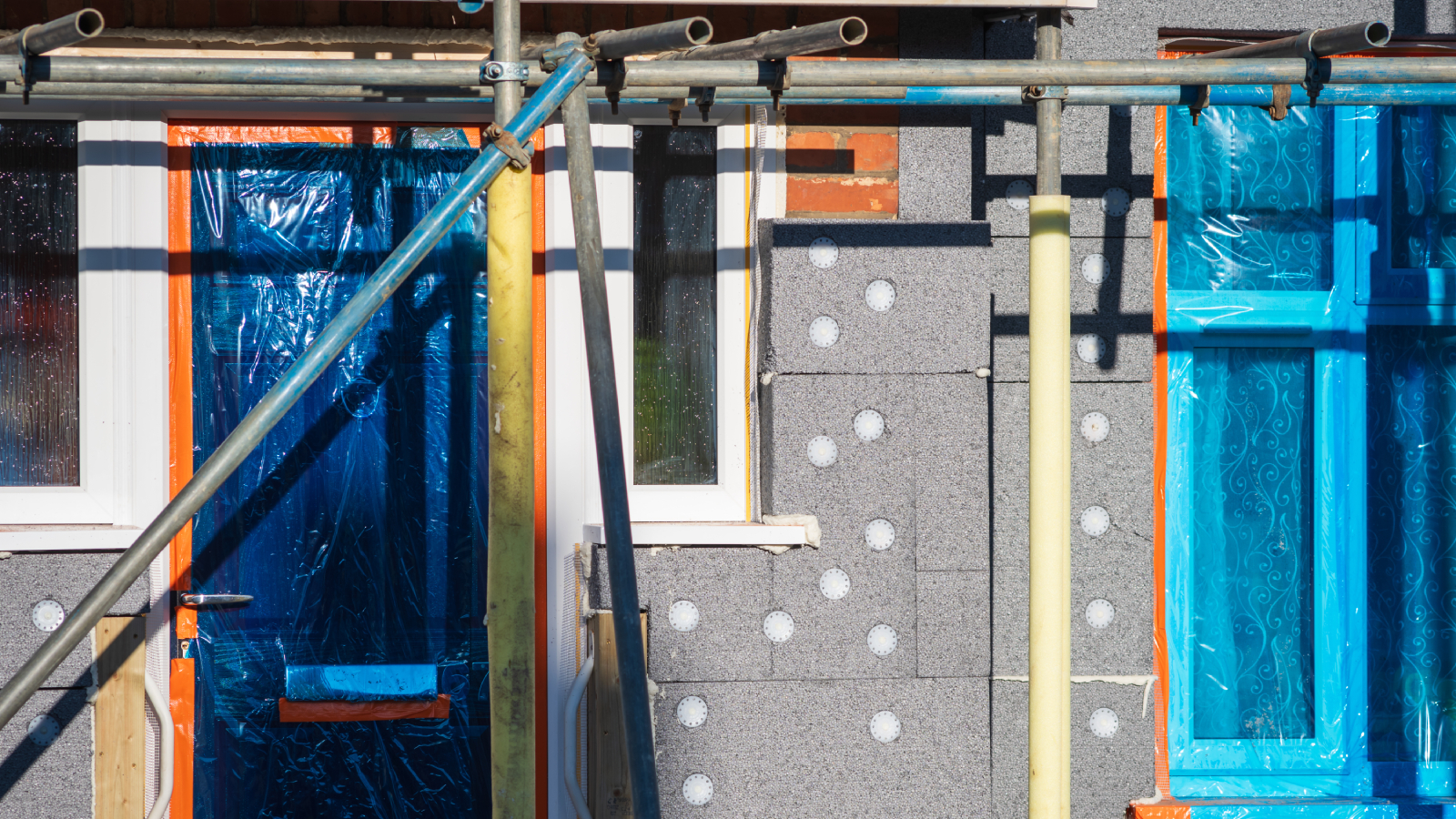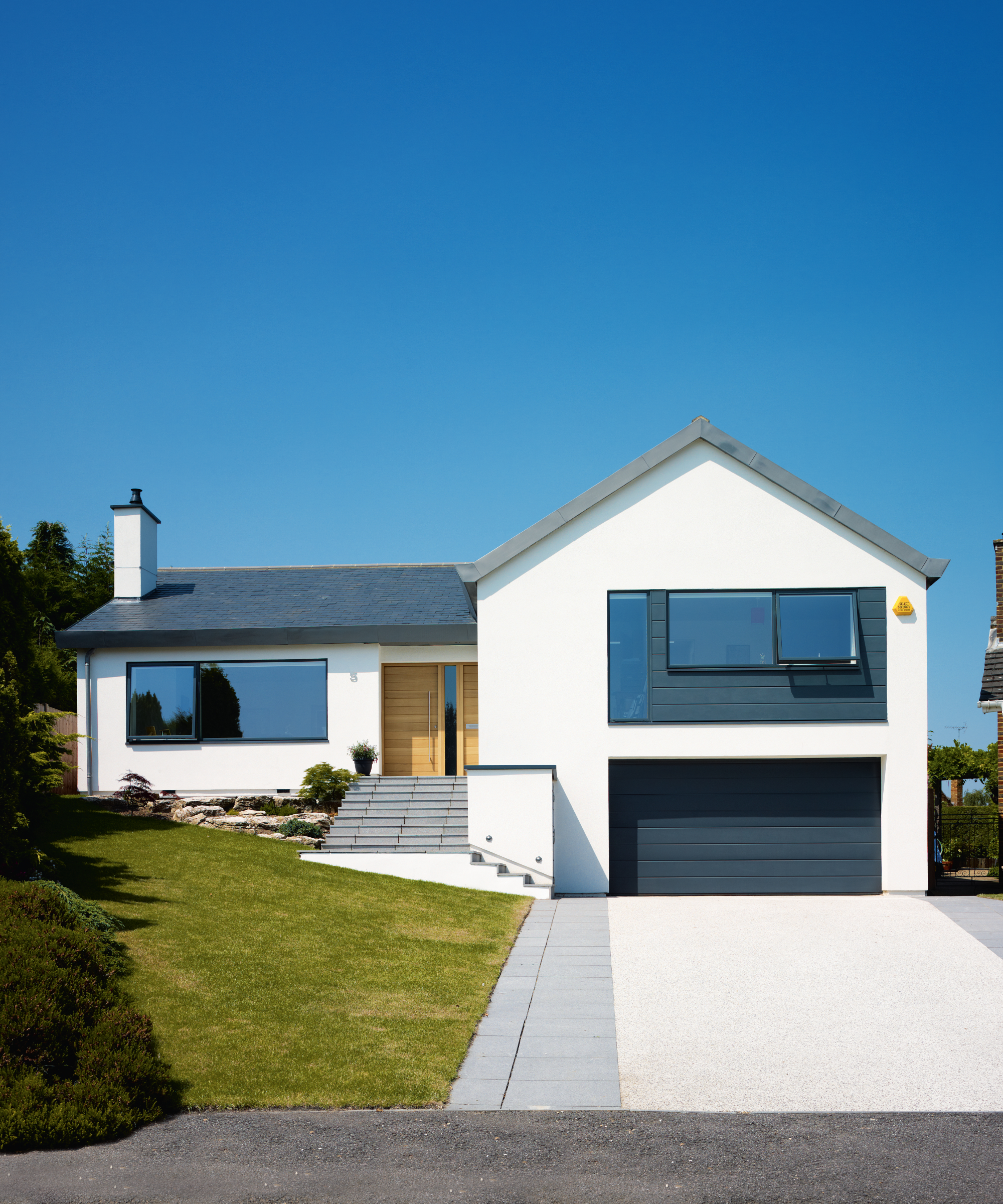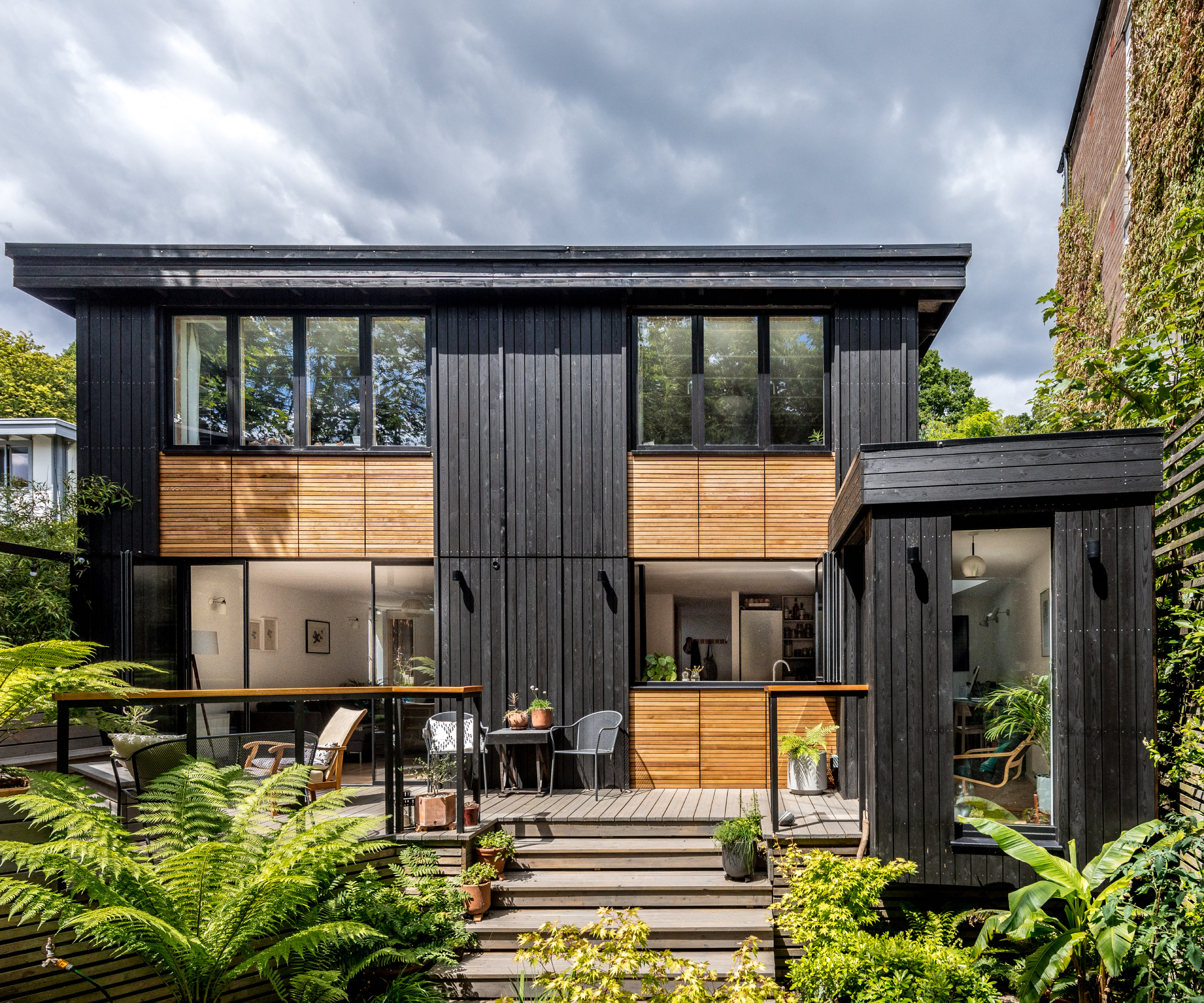This is how much to budget for external wall insulation costs, according to an expert quantity surveyor
Including external wall insulations costs in your budget may increase the final figure, but can help improve the energy efficiency and appearance of your home

If you're looking for a way to improve the exterior of your home, and make it warmer inside, external wall insulation (EWI) combined with a new finish such as cladding or render can achieve both.
But how much does external wall insulation cost and can you afford not to do it when renovating your home?
Expert quantity surveyor, Tim Phillips breaks down the different types of EWI, what you should budget for your external wall insulation costs and all the other factors you need to consider when upgrading your home's appearance and energy efficiency.
Factors affecting costs
In basic terms, EWI involves mechanically applying an insulation layer to a building's exterior walls before covering the insulation with a waterproof mesh and then finishing in cladding or render for protection. Preventing heat leakage through the walls, this layer of insulation helps to save energy use and heating costs. It can also improve a building's visual appeal and offer more defence against deterioration and weathering.
However, a number of factors, such as the building's size and type, the installation's complexity, the material of choice for the insulation, as well as the cost implication of the desired finish will all affect your final external wall insulation costs.
"External wall insulation is significantly more expensive than cavity wall insulation, and also tends to be dearer than lining main walls internally," says chartered surveyor, Ian Rock. However, much depends on the complexity of the job.
"A simple rectangular shaped property with few external obstructions like downpipes and meter boxes should be relatively inexpensive," advises Ian. "It also helps if you’ve got large window sills that project out from the wall to save having to alter or replace the windows.
Bring your dream home to life with expert advice, how to guides and design inspiration. Sign up for our newsletter and get two free tickets to a Homebuilding & Renovating Show near you.
"Another key factor," he adds, "is if you’ve got a generous roof overhang which should save the major expense of having to extend the rafters, roof coverings and guttering to accommodate the thicker walls."


Ian Rock MRICS is a director at Rightsurvey.co.uk and the author of eight popular Haynes House Manuals, including the Home Extension Manual, the Self Build Manual and Period Property Manual.
External wall insulation costs
In general, you can expect to pay external wall insulation costs starting from £8,000 for a terraced house up to around £19,000 for a larger, detached property. There are proprietary systems that require specialist installation, but there are also materials from builders’ merchants that are a lot cheaper.
Generally speaking, EWI may require a larger initial expenditure than typical insulation techniques, but over time, the energy savings and increased comfort can frequently offset the additional costs.
However, there are a variety of EWI systems, each with its own set of unique benefits, drawbacks, and features. The following are a few of the more popular systems and an estimate of their costs.
Insulation | Details | Cost per m2 |
Expanded Polystyrene (EPS) Insulation | EPS insulation is affordable, lightweight, and simple to install. It is suitable for most types of homes, is very popular and is available in different thicknesses. | £60 – £80 (incl materials & installation) |
Extruded Polystyrene (XPS) Insulation | Compared to expanded polystyrene (EPS), extruded polystyrene (XPS) insulation has a greater compressive strength and moisture resistance and is normally used under your damp proof course (DPC). It more costly, but essential in protecting your DPC | £80 – £100 |
Phenolic Foam Insulation | Because phenolic foam boards are thin and have a high heat performance, they are a good option for structures with limited insulation space | £90 – £120 |
Polyurethane (PUR) Insulation | Frequently used in high-performance EWI systems, PUR insulation provides exceptional thermal efficiency. it is one of the costliest options, but you have to weigh this up against your reduced energy bills and the payback period | £100 – £150 |
It's crucial to remember that these cost estimates are approximations and may change based on your project's size, installation complexity, material and finish selection, and property location, among other considerations.
These prices have been checked and deemed suitable for the current time period, but to determine a more precise external wall insulation cost, you should get comprehensive quotations from a minimum of three reliable EWI contractors.
Contact suppliers such as EWI Store who can provide details of potential contractors in your area, as well as costs for a comprehensive range of materials should you wish to buy them yourself.
External finishing costs
Your final external wall insulation costs may vary depending on the finish you choose, with each option such as house rendering vs cladding offering its own sets of benefits and subsequent costs.
Finsh | Details | Cost |
Standard Render Finishes | Compared to luxury finishes like silicone or acrylic renders, standard cement or polymer renders are usually less expensive. These renders offer a weather-resistant, long-lasting surface at a comparatively reduced price | £30-50/m2 |
Acrylic/Silicone Renders | When compared to normal renders, acrylic and silicone renders offer improved flexibility, durability, and colour retention. However, because of their higher calibre and functionality, they are usually more costly | £50-80/m2 |
Pebble Dash | A wet render surface is covered with small stones or aggregates to give a textured finish. Pebble dash may cost less in materials than other render finishes, but it may require more labour during application, which could increase installation costs | £40-60/m2 |
Brick Slips | These add-ons give an EWI project a classic brick finish and can raise or lower project costs. Brick slip installation costs are influenced by various factors, including the type of brick slip, labour required, and installation technique. Since brick slips require more materials and require more skill to apply, they are typically more expensive than standard render finishes | £80-150/m2 |
Cladding | Costs will differ depending on the cladding ideas you select such as timber cladding, PVC, metal cladding, or composite panels. But, even though they they might cost more up front, some cladding materials have long-term durability and aesthetic appeal | £40-120/m2 |
Decorative Finishes | Some decorative finishes – like textured coatings, unique paint effects, or creative designs – may be more expensive. These finishes may cost more, but they can give your home more visual appeal and charm | £50-200/m |

Additional costs
Scaffolding will be required around your property when installing external wall insulation. Analyse your quotation to see if scaffolding costs are included in the price. Scaffolding for a typical three-bedroom semi-detached house costs around £1,000 to hire, with permits and licences.
Arranging for the installation of EWI in conjunction with other remodelling or maintenance tasks might help keep expenses down. If you already have plans to paint your home or repair a roof leak for example, combining these tasks will result in lower costs for labour, plant and scaffolding.
There will also be a cost involved removing/replacing all of the pipes and cables that are fixed to the wall that cannot be avoided.

Available funding
Installing EWI and also other energy-saving measures can be subsidised through a number of government funding opportunities and initiatives. Among the most popular are:
- Energy Company Obligation 4 (ECO 4) – Under this continuous government programme, larger energy companies are required to pay for home energy efficiency upgrades. Your home may be eligible for free or significantly subsidised EWI installations under ECO 4, especially if your home is of low-income and/or receiving specific benefits
- Great British Insulation Scheme – A government programme which helps British homes become more energy-efficient. Targeting the nation's least energy-efficient houses, it is managed by Ofgem and aims to combat fuel poverty and lower energy costs. The programme, commonly referred to as ECO+, is different from the (ECO 4) programme, which is intended for low-income households
- Local Authority grants – A few local authorities provide funds or grants via ECO Flex and LA Flex to encourage energy-efficient improvements, such as the installation of EWIs. For information on available grants and eligibility requirements, take a look at your local authority's website or get in touch with them, as these programmes differ depending on the area
Using the government's online eligibility checker Household energy is the quickest and most straightforward method to begin the application process. You will be asked about your address, council tax band, energy supplier, and whether you are a landlord, renter, or homeowner.
To get the most out of any subsidies or financing, be sure to get numerous quotations and work with accredited installers.
Comparing quotes
To make sure you're getting the best return on your investment, it's important to compare the quotes for your external wall insulation costs, taking into account a number of important elements such as:
Material quality: Evaluate the materials that are suggested. The quality and performance of various finishes and materials for EWI can differ greatly. Verify that the materials are appropriate for your needs and adhere to the relevant industry standards, i.e. Building Regulations and planning constraints.
Insulation thickness: The insulation layer's thermal performance may be affected by its thickness. Examine how each quote compares in terms of insulation thickness and how well it meets your energy-saving objectives. Check the ‘U’ Value of the proposed insulation and ask for a thermal desk study to see what the finished thermal efficiency of the wall will be for differing options.
Installation technique: Consider the suggested installation method described as the durability and quality of the completed EWI system can be impacted by the installation team's skill and experience. Seek out trustworthy installers who have a history of completed installations. Check that your quotation includes for the correct hammer fixings and also includes for starter, corner and stop beads too.
Warranties and guarantees: Do the quotes include any warranties or guarantees regarding the workmanship and materials? A comprehensive warranty can offer protection against future problems and peace of mind. This may be a third-party warranty, which also protects you if your installer becomes insolvent or ceases trading.
Energy efficiency benefits: Take into account the possible energy savings connected to each different product. Some quotations might offer approximations of anticipated energy savings in the future, which could support the case for the initial outlay.
Aesthetics: Assess the suggested EWI system's visual appeal. There are various colours and finishes to select from, silicone render, brick slips or you could even overlay with timber cladding, so choose one that fits your tastes and the architectural design of your house.
Cost transparency: Verify that the quotations include a thorough analysis of all costs, including labour, materials, and any other out-of-pocket charges like scaffolding and skips. Quotes that appear abnormally low should be avoided since they might not include all the required materials or might be a sign of poor craftsmanship.
References and reviews: Find out how well-known the contractors offering the quotes are. To determine client happiness and the calibre of their work, look for online reviews, testimonies, and samples of previous projects.

FAQs
How much will external wall insulation help me save on my energy bills?
Maintaining a building's heat, lowers energy costs significantly. Installing 90mm of EPS onto a solid masonry wall can result in annual energy bill savings of about £455 for a detached four-bedroom home. Variables will obviously come into play, such as the energy efficiency of your home heating system, the building design and existing type of roof insulation, floor insulation, local climate and your heating demands. With the UK facing ever-increasing energy bills, EWI can play a crucial role in achieving household energy efficiency and heating cost reduction.
Will adding external wall insulation increase the value of my property?
Installing EWI and calculating the added value is contingent upon several factors, including its intended purpose, location, and the type of home it would complement. Depending on the original wall construction and its U Value i.e. empty/filled cavity or solid wall and state of the local property market, EWI can raise the value of your home by 5% to 10%.
Consult a nearby estate agent to determine the additional value. It's critical to assess the property values in your neighbourhood. By exercising caution in this manner, you can guard against the risk of investing in external wall insulation costs that don't increase your property's value or payback.
Can I add external wall insulation to a listed building?
As external wall insulation and a new external finish will change the exterior of your property, for all types of properties, including listed buildings you will need to speak to you local planning department before proceeding with any work.
Taking a fabric first approach is always recommended as a starting point for improving your home's energy efficiency. Find out what other costs you can expect to pay when upgrading your home, by taking a look at our expert guides to loft insulation costs and find out your options regarding adding internal wall insulation to your renovation.
Tim Phillips is an experienced senior quantity surveyor and estimator and has worked in the construction industry for over 35 years. He has worked on many varied projects in this time, for corporates, public bodies and private residential clients, managing multi-million budgets.
For the past 13 years, Tim has worked on a freelance basis, whilst managing his rental property portfolio. He has extensive experience of undertaking his own full-scale house renovations. He is also a speaker and expert at the Homebuilding & Renovating Shows.

